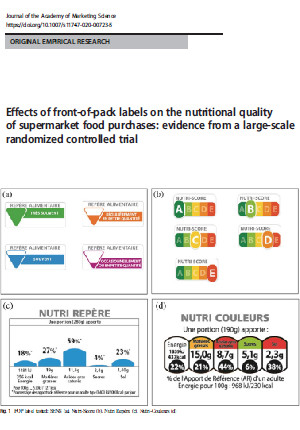Abstract
To examine whether four pre-selected front-of-pack nutrition labels improve food purchases in real-life grocery shopping settings, we put 1.9 million labels on 1266 food products in four categories in 60 supermarkets and analyzed the nutritional quality of 1,668,301 purchases using the FSA nutrient profiling score. Effect sizes were 17 times smaller on average than those found in comparable laboratory studies. The most effective nutrition label, Nutri-Score, increased the purchases of foods in the top third of their category nutrition-wise by 14%, but had no impact on the purchases of foods with medium, low, or unlabeled nutrition quality. Therefore, Nutri-Score only improved the nutritional quality of the basket of labeled foods purchased by 2.5% (−0.142 FSA points). Nutri-Score’s performance improved with the variance (but not the mean) of the nutritional quality of the category. In-store surveys suggest that Nutri-Score’s ability to attract attention and help shoppers rank products by nutritional quality may explain its performance.
Keywords Nutrition . Labelling, Supermarket, RCT, Food, Field experiment, Policy
